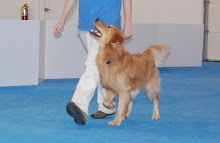 SCAMPER is a problem-solving memory-device tool. I originally learned about it for other purposes, but it's something I use every day in dog training without having to think twice. It's easy to get into the same patterns of thinking instead of looking at all possible options available.
SCAMPER is a problem-solving memory-device tool. I originally learned about it for other purposes, but it's something I use every day in dog training without having to think twice. It's easy to get into the same patterns of thinking instead of looking at all possible options available.S: Substitute: Obviously in animal training we have Response Substitution and can ask for alternate and/or incompatible behaviors. Sometimes another behavior can be used in place of what your dog is currently giving you. Sometimes another behavior can be pro-active and prevent the problem behavior from occurring. There can be other variables we can substitute, including the cues and the environment.
C: Combine: There are often behaviors that a dog already knows or at the very least, preferences that the dog has. How can we combine the known behaviors in his repertoire or skill set to get our desired results?
A: Adapt: How can we change what we already have? With a little extra work or a few changes to variables, we may be able to use a behavior we already have. We can change perceptions and make it go well.
M: Modify: There are changes we can make to the environment to increase or decrease the chances of getting specific behaviors. When dealing with problem behavior, we want to be sure we aren't compromising our training by allowing the undesirable behaviors to happen at other times.
P: Put to Other Purposes: The sort utilize the problem behavior for your benefit. Turn your unwanted behaviors into tricks. Your puppy is picking up everything? Teach him to bring the items to you.
E: Eliminate: Some behaviors we absolutely never want to see. Look at the behavior closely before working to be sure that you are getting rid of the parts you dislike and you aren't accidental getting rid of behavior you will want later. A dog who doesn’t get on furniture can be nice...but if he also doesn't know how to get into the car...that can be another challenge. We can eliminate behaviors, eliminate triggers, put behaviors on cues and eliminate our use of the cue.
R: Rearrange: By changing associations or the strength of associations we can change behavior. We can teach dogs to be enthusiastic in certain times and places. We can teach our dogs to like two things equally. We can take away opportunities for reinforcement to make other behaviors less likely to occur.




No comments:
Post a Comment